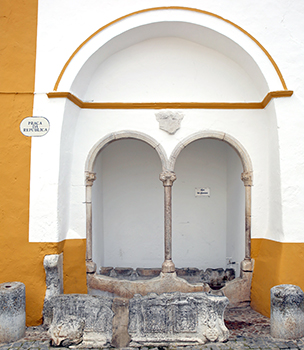 |
The date of its construction is unknown, but in 1313 already exists reference to the Fonte Grande (the big fountain), which we assume is the same that today is known as Fonte da Praça (town square fountain).
From 1683 onwards it probably came to be absorbed by the new building of the Town Council and the prison, built in the square after that date. There are however indications that it may have been displaced from its original place, in the vicinity of its present place, as a way of promoting the planning of the surrounding space.
Because of its frequent clogging and the diversion of waters that were lost without utility, it was rebuilt in 1694 by the pipe master of Évora’s Água da Prata (aqueduct), Matias Ferreira.
With spring in the backyard of a house in Largo de São Luís (Saint Luís square), whose water was joined by the one coming from the spring of Poço Novo. This one was roughly located at the intersection of the current street António Isidoro de Sousa with the current street Miguel Bombarda.
The oldest part, besides the cup that receives the water, and three gargoyles of discharge, shows two twin arches that rest on columns with Corinthian capitels and bases of floral decoration. Structures that were built in white marble and fit in the style of the Renaissance, from which comes its other sometimes used designation: Fonte da Renascença (Fountain of the Renaissance). In the upper part it shows traces of what would have been a royal coat-of-arms that is now mutilated.
At a short distance it has a bulkhead, also of marble, that would have been reutilized from another construction. On it we find figures in relief, such as a female figure who seems to be dancing, birds, wolfdogs, a vase with flowers and other stylized motifs stand out.
To complete the set are cylindrical structures in marble that might also have come from another initial use.
Protection: Monument of Public Interest / ZEP, Portaria n.º 504/2011, DR, 2.ª série, n.º 76, 18 Abril 2011. The ZEP is coincident with the Castle and Matriz Church ZEP
REFERENCES
BAIÃO, Francisco, “Ciclo da Água”, Boletim Municipal do Município de Viana do Alentejo, nº67, Julho de 2010, pp. 21-22.
ESPANCA, Túlio, Inventário Artístico de Portugal: Distrito de Évora: Concelhos de Alandroal, Borba, Mourão, Portel, Redondo, Reguengos de Monsaraz, Viana do Alentejo e Vila Viçosa, Lisboa, Academia Nacional de Belas-Artes, 1978,Tomo IX, Vol. 1.

 Abrir Lista
Abrir Lista MUNICÍPIO DE VIANA DO ALENTEJO
MUNICÍPIO DE VIANA DO ALENTEJO